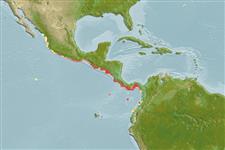>
Anguilliformes (Eels and morays) >
Ophichthidae (Snake eels) > Ophichthinae
Etymology: Ophichthus: Greek, ophis = serpent + Greek, ichthys = fish (Ref. 45335); apachus: Name from Greek meaning without and thickness, (probably referring to its thin body)..
More on authors: McCosker & Rosenblatt.
Environment: milieu / climate zone / depth range / distribution range
البيئة
بحري القاع; نطاق العمق 0 - 8 m (Ref. 31243). Tropical
Eastern Central Pacific: Mexico and Colombia.
الحجم / وزن / العمر
Maturity: Lm ? range ? - ? cm
Max length : 23.1 cm TL ذكر/ مختلط الجنس; (Ref. 31243)
وصف مختصر
مفاتيح التعريف | الوصف الخارجي | قياسات المظهر الخارجي
فقرات: 180 - 186.
Size pertains to immature specimen. Occurs over sand bottoms (Ref. 31243).
Life cycle and mating behavior
Maturities | التكاثر | Spawnings | Egg(s) | Fecundities | Larvae
McCosker, J.E. and R.H. Rosenblatt, 1998. A revision of the Eastern Pacific snake-eel genus Ophichthus (Anguilliformes: Ophichthidae) with the description of six new species. Proc. Calif. Acad. Sci. 50(19):397-432. (Ref. 31243)
IUCN Red List Status (Ref. 130435)
استخدامات بشرية
مصائد: غير ذات اهمية
أدوات
تقارير خاصة
Download XML
مصادر علي الأنترنت
Estimates based on models
Phylogenetic diversity index (Ref.
82804): PD
50 = 0.5000 [Uniqueness, from 0.5 = low to 2.0 = high].
Bayesian length-weight: a=0.00089 (0.00039 - 0.00204), b=3.00 (2.80 - 3.20), in cm total length, based on LWR estimates for this (Sub)family-body shape (Ref.
93245).
مستوى غذائي (Ref.
69278): 3.7 ±0.6 se; based on size and trophs of closest relatives
المرونه (Ref.
120179): عالي, الحد الزمني الأدني لتضاعف عدد أفراد المجتمع أقل من 15 شهر (Preliminary K or Fecundity.).
Fishing Vulnerability (Ref.
59153): Low vulnerability (13 of 100).
